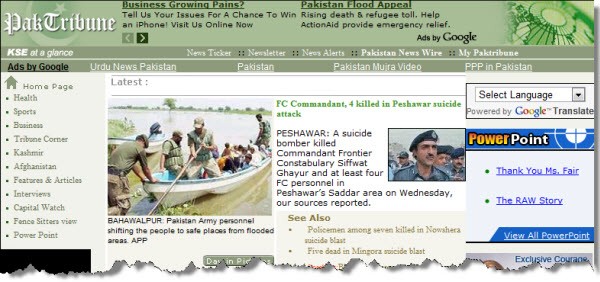As Pakistan turns 63 years old in exactly nine days time, its worst floods in 80 years have left up to 3 million souls stranded amid outbreaks of disease after monsoon rains forming floods kill almost 1,500 people.
The situation is grim over most of the country. The water which broke from breached Muzaffargarh canal is now a threat to the nearby oil refinery and Kot Addu Power Station which produces 1400 megawatts of power. “Main highways are cut off as bridges across the country’s inflated northern rivers have been washed away,” said the International Committee of the Red Cross (ICRC).
According to the National Disaster Management Authority (NDMA): “More than 29,500 houses were damaged and a key trade highway to China was blocked by flooding.”
Over 900,000 cusecs of water was released from the head Chashma in Layyah over the past three days, now posing a threat to Taunsa. “The floods have damaged 8,16,842 acres of crop across the Punjab province,” said Shahbaz Sharif, Chief Minister of Punjab province.
The South province of Pakistan, Sindh, is to face the worst of all, as the combination of the flood streams from the north and north-east finally heads down to the south. About 100,000 extra cusecs of water has entered the Guddu Barrage and the level is speedily mounting in River Indus. The water level at Guddu Barrage now points to 470,000 cusecs and to 225,000 cusecs at the Sukkur Barrage in Sindh.
“Sindh has been put on code red and there are fears that up to 150,000 people could be displaced in the province,” says a government official. “In case of further rain, it is expected that out of 23 districts in the Sindh province, 19 will be affected.”
Torrential rains are forecasted for the next two days by the meteorological department, so the River Indus will be in a very high flood situation. DG Met Office Qamar-uz-Zaman Chaudhry forewarns: “The first half of the current month [until August 15] is critical as another system of heavy rains would enter Sindh province from Bay of Bengal on August 8 or 9.”
The Pakistan Army has rescued over 60,000 stranded people in the last five days, a spokesperson of the Inter-Services Public Relations (ISPR) said on Wednesday. Some 40 helicopters and 450 army boats are participating in the continuing rescue activities in the wide spread areas of the country.
The army is also providing cooked food to flood-affected people at Army relief camps, set up at diverse places. Army engineers are working on opening roads and making diversions to facilitate the flow of traffic. Around 2,600 tourists have been evacuated from Kalam. Thirty Chinese engineers, who were working on the Dobair-Khwar Hydel project in Kohistan, have been safely evacuated to Bisham. Helicopters and boats have so far ferried 28,000 people to safety from the areas nearby.
Pakistani officials warn the shortage of drinking water is spreading diseases, including cholera, a stern bacterial infection which chiefly affects the small intestine. Syed Zahir Ali Shah, health minister for the Khyber-Pakhtunkhua province, says around 100,000 souls, mostly children, are suffering from illnesses such as gastroenteritis, involving both the stomach and the small intestine, resulting in acute diarrhea.
Nizam Gul, a dweller from Nowshera who has been relocated to a camp, talks of the horror. “The relief camps set up by authorities are just showpieces; there’s no food or medicine available there,” he said. Another flood victim, Ilyas Khan, complains there is no proper system for food distribution: “They throw food at us as if we are animals and not humans.”
Bistma Bibi, 65, who has lost her two grandsons in the floods, accuses government relief workers of only serving friends or relatives. “I came here in the morning. I did my best. I begged and fought but got nothing. They’re giving them to their people,” she said.
More people at the camps say that the only relief from the crushing heat is plastic hand fans and the fact that there are no proper washrooms is contributing to an outbreak of waterborne diseases.
Pakistan’s strongest ally China has announced an aid package worth US$1.5 million including medicines, tents, water purifiers and 50 power generators. UN Secretary-General Ban Ki Moon has authorised the disbursement of up to $10 million from the UN Central Emergency Response Fund (CERF) to help address the immediate needs of those affected by the floods. The United Kingdom has pledged $8 million in aid shortly before Pakistani President Asif Ali Zardari travelled to London on his controversial state visit. Australia, Canada, Indonesia and South Korea have also confirmed aid donations.
Authorities expect the death toll to rise, as the meteorological office forecasts rains of up to 200 millimeters (eight inches) in the next weeks across the country. Hoping to see less people drowning away in the madly rushing waters.
*Farrukh Zafar is a writer and computer science student in Pakistan. He blogs at FarrukhUNPLUGGED.com. Information and quotes are taken from a variety of local media outlets.









We read: “Over 900,000 cusecs of water was released from the head [waters] … three days … damaged 8,16,842 acres of crop”
Converts to: “A flood on the Indus, flowing at 25,000 cubic metres per second, has damaged 3,300 square kilometres of crop in just three days.”
It was the Taliban that did it!
The people of Pakistan are enduring appalling hardships, with news virtually every day of horror and suffering. Another perspective on the way its own government is addressing the floods is equally appalling, if Pakistan’s leading newspaper is to be believed: http://www.dawn.com/wps/wcm/connect/dawn-content-library/dawn/the-newspaper/front-page/19-gilani-makes-it-to-mianwali%2C-displays-his-healing-touch-580-hh-08.
Magical powers indeed.
They should reunite with India